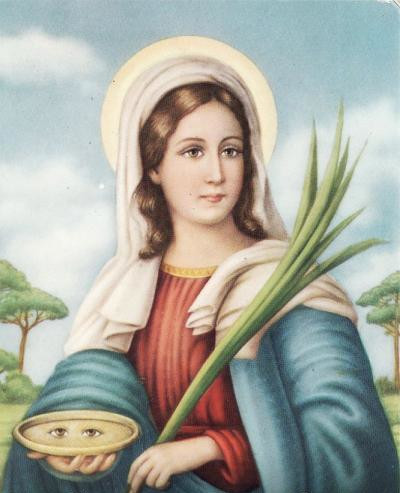
Saint of the Day December 13: St. Lucy
St. Lucy: History, Traditions and Meaning of the Martyr and Protector of Sight
Name
St. Lucy
Title
Virgin and martyr
Birth
281, Syracuse
Death
December 13, 304, Syracuse
Recurrence
13 December
Prayer
O glorious martyr and lovable St. Lucy, example of fortitude, sacrifice and Christian faith, who, protected by the Holy Spirit, were unharmed by the fire that surrounded You and survived unspeakable torments of martyrdom, grant me the strength to overcome the adversity of the world and strengthen me in the faith by the imitation of Your virtues; obtain for me from Your Spouse and my Redeemer Jesus the Grace may the light of my eyes always be kept healthy, and may I always make good use of it for the good of my soul. So be it.
Patron Saint Of
Siracusa, Belpasso, Savignano sul Rubicone, Carlentini, Copparo, Medicina, Santa Lucia di Piave, Prata di Pordenone, Acqualagna, Santa Sofia
Protector of
Blind people, electricians, eye diseases and famines, eyes, eye doctors, eyesight
Roman Martyrology
Memory of St. Lucy, virgin and martyr, who guarded, as long as she lived, the lighted lamp to go forth to meet the Bridegroom and, in Syracuse, Sicily, led to death for Christ, deserved to access with him the wedding of heaven and to possess the light that knows no sunset.
The Saint and Mission
St. Lucy, venerated as a martyr in the Christian tradition, embodies the Christian mission in an exemplary way through her courage, fidelity and sacrifice. Her story, rooted in the fourth century during Diocletian’s persecutions, reflects a deep dedication to the Christian faith and an indomitable commitment to witness to Christ even in the face of death.
St. Lucy’s mission is manifested primarily through her martyrdom. Refusing to deny her faith and marry a pagan, as requested by her family, she chose to remain faithful to her Christian principles. This decision not only shows her personal courage but also her firm belief in the broader mission of Christianity, which is to remain steadfast in the faith despite persecution and trials.
A crucial aspect of St. Lucy’s story is her choice to distribute her possessions to the poor, an act that testifies to her deep compassion and commitment to Gospel values. This gesture of generosity and service to the less fortunate is a living example of Jesus’ command to love and serve others, especially those in need.
St. Lucy is also known for her intercession and protection, particularly for those suffering from eye problems. This aspect of her cult emphasizes her continuing mission in the heavenly realm, where, according to the Christian faith, saints intercede for us with God. Her popularity as a patron saint reflects the belief in her ability to bring comfort and help to those who turn to her in prayer.
St. Lucy’s life and martyrdom offer us a powerful example of how Christian mission can be lived out with unconditional faith, courage and generosity. Her story continues to inspire the faithful to live their faith with depth and sincerity, reminding us that true Christian mission often requires sacrifice, compassion and an unwavering commitment to serve others in the name of Christ.
The Saint and Mercy
St. Lucy, the Christian martyr whose life and sacrifice are celebrated in many traditions, deeply embodies the concept of mercy in the Christian faith. Her story, which dates back to the fourth century during Diocletian’s persecutions, is an example of how mercy can be expressed through the act of personal sacrifice and care for others.
Mercy in St. Lucy’s life is manifested first and foremost in her commitment to the poor. Before suffering martyrdom, Lucy made the choice to distribute her possessions to the needy, an act of generosity that reflects the heart of Christian mercy. This gesture not only demonstrates her compassion for those in need, but also her deep understanding of Christ’s teaching on the importance of helping and serving others.
Another aspect of her life that highlights mercy is her decision to remain faithful to her faith despite pressure and threats. St. Lucy’s refusal to abjure her faith or perform acts contrary to her Christian principles is an example of mercy towards herself and her faithfulness to God. It shows that true mercy sometimes involves standing firm in one’s principles, even in the face of grave personal consequences.
Moreover, the veneration of St. Lucy as the patroness of sight reflects a broader aspect of mercy – that of offering hope and comfort. The tradition that recognizes her as an intercessor for those suffering from eye problems is a reminder that mercy can extend beyond our time and place, touching the lives of many generations.
St. Lucy’s life and martyrdom are a powerful testimony to mercy as a central element of Christianity. Her story invites us to reflect on how we can exercise mercy in our own lives-through acts of generosity, fidelity to our principles and offering comfort and hope to others. His legacy continues to inspire and guide the faithful on the path of mercy and service.
Hagiography
Lucy was born in Syracuse in the year 281 to a very noble and wealthy family. Left fatherless at the age of five, she was educated in the Christian religion by the pious and wise Eutychia, her mother.
Made an adult and inflamed with pure love of God, she decided unbeknownst to her mother to maintain perpetual virginity. Ignorant of this secret the good Eutychia, as was then the universal custom, was not slow to take an interest in finding her daughter a suitable bridegroom. This was a young nobleman, rich and…
